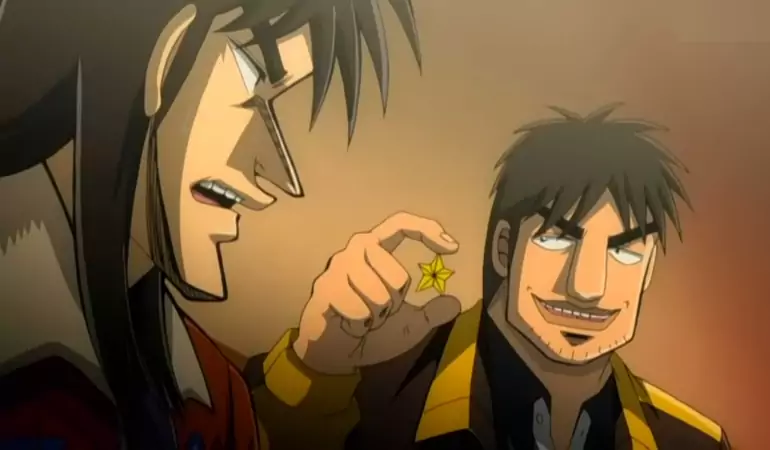Gyakkyou Burai Kaiji: Ultimate Survivor Anime Review

Introduction
In today's world, encountering someone unfamiliar with anime is a rarity, given its unique characteristics that distinguish it from its Western counterpart. Casual viewers often link it to supernatural powers, epic battles, illogical events, colorful and unconventional hair, and, of course, a plot that unfolds in settings rarely explored in anime and manga. Here, we refer to stories that seamlessly capture the sensations one would feel while gambling, each narrative achieving a perfect realism, immersing the reader in the adrenaline of betting, whether in a real casino or an online one.
However, certain series deviate from these common elements and instead delve into real-life events, cultivating a distinctive atmosphere within the anime realm.
'Kaiji' originated as a manga crafted by the Japanese artist Nobuyuki Fukumoto and published by Kōdansha in 1996, receiving its anime adaptation in 2007. Classified within the seinen genre (aimed at young adults), the narrative follows an unemployed young man entangled in the world of illegal gambling.
A notable aspect of 'Kaiji' is its prowess in constructing highly intricate scenarios derived from deceptively simple games of chance. In this series, psychological intricacies take precedence over mere luck, adding depth to the narrative.
What is the anime about?
The storyline unfolds in 1996, during the peak of the Asian financial crisis. Against this backdrop, we encounter Kaiji Itou, who is mired in a stagnant life. Having fruitlessly searched for employment for over a year, he remains idle, squandering the little money he has on alcohol and unsuccessful bets where luck seldom smiles upon him.
In addition, Kaiji channels his frustration into acts of vandalism, such as damaging expensive cars, guided by his twisted belief that "Anyone who owns a car like this can't be a good person."
While Kaiji laments about his life, a man wearing dark glasses pays him a visit. This individual wants to talk to him about Furuhata, a former colleague of Kaiji who has gone missing and has been avoiding payment of a 300,000 yen debt for over a year, for which Kaiji acted as a guarantor.
To worsen the situation, Furuhata has been neglecting the debt for 14 months, and the interest has exponentially increased, inflating the debt to 3,850,000 yen. In theory, this means that Kaiji will have to pay monthly for at least 11 years. However, the collector offers him a golden opportunity.
Within a month, a ship will set sail where he will have the chance to settle his debt by facing other gamblers and debtors like himself. Those who lose will further inflate their respective debts, while the winners will be completely forgiven of all their outstanding dues. Moreover, there is the possibility that some may even come out with million-yen profits.
Kaiji, uncertain about taking this opportunity, is persuaded by the collector, who prompts him to reflect on how his life has been in recent years. Ultimately, the collector manages to convince him.
A month later, Kaiji boards the ship, finding it filled with individuals facing failures similar to his own, giving him a sense that things won't be easy.
After receiving some instructions, our protagonist gets a pair of envelopes containing items for the games. On one hand, there are cards illustrating the 'rock, paper, scissors' game, and on the other hand, there are 3 stars. The rules of the game are explained, and the competition among the failures kicks off.
Kaiji encounters a person who suggests a deal to ensure both of them emerge victorious from the first game. However, this individual ends up betraying him, pushing Kaiji to the edge of elimination. At that critical moment, Kaiji comes across Furuhata, who has been missing until then. Together with a third member, they devise a plan to reclaim what they have lost.
However, this latter individual also ends up betraying both Kaiji and Furuhata, and the situation becomes critical. Despite this, they choose to forgive him and seek out a new gambler to challenge. That's when they encounter a man with whom they finally secure their first victories, thanks to a method called the 'Gambler's Fallacy.' This principle posits that certain gamblers will be influenced by similar results when placing their bets. For example, in a coin toss, if the coin lands on 'tails' five times in a row, some gamblers may choose to bet on 'tails' again, despite the fact that in a coin toss, there's a 50% chance of it landing on heads or tails.
This is how Kaiji recovers some stars for his team while hoping to find more gamblers who fall for their tactics.
Can Kaiji and his team safely escape from that ship? Can he settle his debts and start anew? Discover the answers by watching the series or reading the manga!
Animation
The artwork in the anime falls short in certain scenes, particularly in the early episodes. The occasional use of computer-generated effects contrasts too sharply with the series' style, revealing its production limitations. However, the meticulous detailing of the environments enhances the sense of realism, allowing viewers to immerse themselves more deeply in the story, even though the characters have exaggerated designs.
Music
The soundtrack, composed by Hideki Taniguchi, known for his work on series like Death Note, plays a crucial role in establishing the appropriate atmosphere for each situation. Consequently, despite the leisurely narrative pace, viewers are likely to remain engaged.
Si quieres conocer otros artículos parecidos a Gyakkyou Burai Kaiji: Ultimate Survivor Anime Review puedes visitar la categoría Reviews.

Leave a Reply